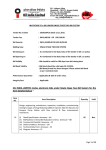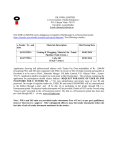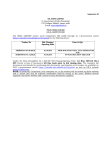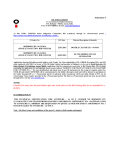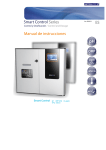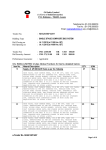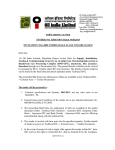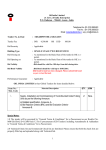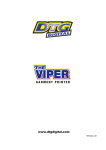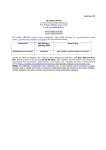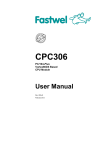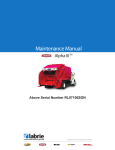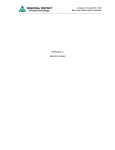Download SGG9305P16 - Oil India Limited
Transcript
PO : Udayan Vihar Guwahati – 781171, Assam (India) Phone: +91-361-2594286 Fax: +91-361-264386 Email: [email protected] [email protected] INVITATION TO e-BID UNDER SINGLE STAGE TWO BID SYSTEM Tender No. & Date : SGG9305P16 dated 23.11.2015. Tender Fee : INR 6,000.00 OR USD 100.00 Bid Security : INR 7,52,000.00 OR USD 12,600.00 Bidding Type : SINGLE STAGE TWO BID SYSTEM Bid Closing on : As mentioned in the Basic Data of the tender in OIL’s e-portal. Bid Opening on : As mentioned in the Basic Data of the tender in OIL’s e-portal. Bid Validity : Bid should be valid for 180 days from bid closing date. Bid Bond Validity : Bid Bond should be valid upto 27.01.2017. (Bid bond format has been changed. Please submit bid bond as per revised format) Performance Guarantee : Applicable @ 10% of order value. Integrity Pact : Applicable OIL INDIA LIMITED invites electronic bids under Single Stage Two Bid System for the item detailed below – Item No. Material Code Item Description Qty UoM Line pipe conforming to API 5L, Grade 46 in double Random lengths and 3500 ends beveled of following specification:- Outer Diameter: 406.4 mm (16 inch); Wall Thickness: 11.91mm (0.469 inch); Weight : 115.87 kg/m; Std. Test Pressure: 85% SMYS. Detail specification in Annexure - AA Mtrs 3LPE COATED LINE PIPE, 406.4 mm OD, API-5L GR-46, ERW/LSAW (PSL-2), 11.91 mm WT. 10 99067696 3LPE COATED LINE PIPE, 355.6 mm OD, API-5L GR-46, ERW/LSAW (PSL-2), 11.91 mm WT 20 99067695 Line pipe conforming to API 5L, Grade 46 in double Random lengths and 500 ends beveled of following specification:- Outer Diameter: 355.6 mm (14 inch); Wall Thickness: 11.91mm (0.469 inch); Weight: 100.96kg/m; Std Test Pressure: 85% SMYS. Detail specification in Annexure - AA Mtrs Page 1 of 30 STANDARD NOTES: 1.0 The tender will be governed by “General Terms & Conditions” for e-Procurement as per Booklet No. MM/GLOBAL/E-01/2005 for E-procurement (ICB Tenders) including Amendments & Addendum to “General Terms & Conditions” for e-Procurement. 2.0 Nil custom duty shall not be applicable against this tender. Indigenous bidders are requested to quote non Deemed Export prices. 3.0 Please note that all tender forms and supporting documents are to be submitted through OIL’s eProcurement site only except following documents which are to be submitted manually in sealed envelope super scribed with Tender no. and Due date to The Chief Materials Manager (PL), Oil India Limited (Pipeline Headquarter), P.O. Udayan Vihar, Guwahati -781171 before 14.00 Hrs. IST on the Bid Closing Date mentioned in the Tender. a) Original Bid Security. b) Any other document required to be submitted in original as per tender requirement. All documents submitted in physical form should be signed on all pages by the authorised signatory of the bidder and to be submitted in triplicate. 4.0 Tender Fee and Bid Security can also be paid through payment gateway in the e-tender portal. Please refer to Vendor User Manual updated in the e-tender portal as well for further details. 5.0 In case of SINGLE STAGE-TWO BID SYSTEM, bidders shall prepare the “Techno-commercial Unpriced Bid” and “Priced Bid” separately and shall upload through electronic form in the OIL’s e-Tender portal within the Bid Closing Date and Time stipulated in the e-Tender. The “Techno-commercial Unpriced Bid” shall contain all technical and commercial details except the prices which shall be kept blank. Details of prices as per Bid format / Commercial bid to be uploaded as attachment in the Attachment Tab “Notes and Attachments”. A screen shot in this regard is given below. Any offer not complying with above submission procedure will be rejected as per Bid Rejection Criteria mentioned in the tender. Go to this Tab “Technical RFx Response” for Uploading “Technocommercial Bid”. Go to this Tab “Notes and Attachments” for Uploading “Priced Bid” files. Page 2 of 30 On “EDIT” Mode- The following screen will appear. Bidders are advised to upload “TechnoCommercial Un-priced Bid” and “Priced Bid” in the places as indicated above: Bid on “EDIT” Mode Area for uploading TechnoCommercial Bid* Area for uploading Priced Bid** 6.0 Bidders are requested to examine all instructions, forms, terms and specifications in the bid. Failure to furnish all information required as per the NIT or submission of offers not substantially responsive to the bid in every respect will be at the bidders risk and may result in rejection of its offer without seeking any clarifications. 7.0 All the Bids must be Digitally Signed using “Class 3” digital certificate (e-commerce application) with organisation name as per Indian IT Act obtained from the licensed Certifying Authorities operating under the Root Certifying Authority of India (RCAI), Controller of Certifying Authorities (CCA) of India. 8.0 Bidders must ensure that their bid is uploaded in the system before the tender closing date and time. Also, they must ensure that all documents which are to be submitted in a sealed envelope are also submitted at the address mentioned in note 3.0 above before 14:00 Hrs (IST) on the bid closing date failing which the offer shall be rejected. 9.0 Two Bid System shall be followed for this tender and only the price-bids of the bidders whose offers are commercially and technically acceptable shall be opened for further evaluation. 10.0 Other terms and conditions of the tender shall be as per General Terms and Conditions for Global Tender (MM/GLOBAL/E-01/2005). However, if any of the clause of the Bid Rejection Criteria / Bid Evaluation Criteria (BEC / BRC) contradicts the clauses in the General Terms & Conditions of Global Tender of the tender and/or elsewhere, those mentioned in the BEC / BRC shall prevail. 11.0 In the event of receipt of only a single offer against the tender within B.C. date, OIL reserves the right to extend the B.C. date as deemed fit by the Company. During the extended period, the bidder who has already submitted the bid on or before the original B.C. date shall not be permitted to revise their quotation. Page 3 of 30 12.0 To ascertain the substantial responsiveness of the bid OIL reserves the right to ask the bidder for clarification in respect of clauses covered under BRC also and such clarifications fulfilling the BRC clauses in toto must be received on or before the deadline given by the company, failing which the offer may be summarily rejected. 13.0 The Integrity Pact is applicable against this tender. OIL shall be entering into an Integrity Pact with the bidders as per format enclosed vide Annexure XII of the tender document. This Integrity Pact proforma has been duly signed digitally by OIL’s competent signatory. The proforma has to be returned by the bidder (along with the technical bid) duly signed (digitally) by the same signatory who signed the bid, i.e., who is duly authorized to sign the bid. Uploading the Integrity Pact with digital signature will be construed that all pages of the Integrity Pact has been signed by the bidder’s authorized signatory who sign the Bid. The name of the OIL’s Independent External Monitors at present are as under: SHRI RAGHAW SHARAN PANDEY, IAS (Retd.), Former Secretary, MOP & NG, e-Mail ID : [email protected] SHRI RAJIV MATHUR, IPS (Retd.) Former Director, IB, Govt. of India, e-Mail ID : [email protected] 14.0 No press advt. will be published regarding amendment to Bidding Document or extension of Bid Closing Date. The same will be uploaded in OIL’s website and informed to all prospective bidders who have received the bidding documents. Bidders to keep themselves updated. SPECIAL NOTES: 1.0 Marking is to be done on each joint as per API Spec 5L covering, manufacturer's mark/name, API monogram, size, weight, grade, manufacturing process, heat treatment, test pressure, length. Marking should be in metric unit. Additionally, 'OIL' logo/mark and the purchase order number shall be die stamped or paint stenciled on each joint. 2.0 In the event of an order, the supplier shall submit time-schedule as well as QAP for manufacture of line pipe and coating application including 'third party inspection' programme, the proposed agency and their credential for OIL's approval. 3.0 In the event of an order, the supplier shall intimate OIL at least 15 (fifteen) days in advance prior to starting the 'third party inspection' to enable OIL for associating their personnel to witness the process of manufacturing and coating. 4.0 Materials shall be procured from the same source. Bidders shall quote for both the items. 5.0 DELIVERY: Delivery of the materials must be completed within 20 weeks. However, Bidder to quote their best delivery period. Sd(M.B. SINGHA) DEPUTY MANAGER MATERIALS (PL) FOR CHIEF MANAGER MATERIALS (PL) FOR: GROUP GENERAL MANAGER (PLS) Page 4 of 30 ANNEXURE - AA DETAILED TECHNICAL SPECIFICATIONS OF 3-LAYER POLYETHYLENE COATED API 5L (PSL-2) LSAW LINE PIPE 1.0 SCOPE OF WORK: Fabrication/manufacturing of pipes, packing and forwarding to coating facility, external coating of pipes and despatch to Guwahati (Assam) Dump sites of OIL. GENERAL NOTES FOR LINE PIPES & 3 LPE COATED PIPES 2.0 SPECIFICATIONS: 2.1 Line Pipes must be manufactured as per API specification 5L (PSL2) LSAW, latest edition and must bear API monogram. A valid API Specification 5L certificate from the manufacturer shall be submitted along with the quotation without which offer shall be rejected. 2.2 The pipes shall be brand new, unused, and of prime quality and in double random length without any jointers. 2.3 Mill Coating: Mill Coating shall be done as per API Specification 5L (latest edition) and adequately oiled to withstand sea voyage / road transport. The mill coating must either be compatible to coal-tar primer / synthetic primer used for coal tar enamel coating or should be of such material constituent which can be easily cleared by scrapping. 2.4 Pipe ends: Ends must be prepared as per relevant API specifications. Suitable end protectors as specified shall be used to protect the ends. 2.5 The offer must contain detailed description of the materials. Insufficient description will lead to rejection of the offer. 3.0 MILL INSPECTION / CERTIFICATION All line pipes shall be manufactured, tested and certified in accordance with API Specification 5L (PSL-2), latest edition. 4.0 PHYSICAL / MECHANICAL TEST: The following tests shall be carried out on each heat of steel from which the pipes are manufactured as per API Specification 5L, the latest edition and test results thereof shall be submitted to OIL along with the materials. (i) (ii) (iii) (iv) (v) (vi) (vii) (viii) (ix) (x) Chemical Analysis Heat Analysis Product Analysis Recheck Analysis Mill-Control Check Analysis Tensile tests Yield strength tests Mill control tensile tests Weld ductility tests Dimension and weight tests including drift and straightness. Page 5 of 30 4.1 While conducting the above tests if any of the pipe fails, retest of the same shall be carried out as per API Specification 5L,(PSL-2), the latest edition. 4.2 Hydrostatic Test: Each joint of pipe shall be tested hydrostatically to the recommended pressure at the mill in accordance with the relevant API specifications. 4.3 Non-Destructive Tests: Non-destructive tests shall be carried out as specified in API Specification 5L, ,(PSL-2), the latest edition. 4.4 Bidders should give details of mills inspection and QC methods available. OIL may require such details in case of an Order. 5.0 THIRD PARTY INSPECTION FOR LINE PIPES: Inspection by an independent third party shall be carried out for both bare Line Pipes and 3LPE Coated Pipes separately. (A) Third Party Inspection for Bare Line Pipe (B) Third Party Inspection for Coated Line Pipe 5.1 Third Party Inspection for Bare Line Pipe: Inspection for the Bare Line Pipe shall cover the following: (i) (ii) (iii) (iv) (v) (vi) (vii) (viii) (ix) (x) (xi) (xii) (xiii) (xiv) (xv) (xvi) 5.1.1 Material Identification Stage inspection at random visit basis during manufacturing Audit and endorsement of all chemical analysis and physical test reports Witness dimensional checks Witness mechanical tests (as per API 5L(PSL-2), the latest edition) Witness NDT Witness hydrostatic tests Visual inspection for imperfection Longitudinal defect identification Transverse defect identification Wall thickness measurement Joint Inspection & Grade confirmation End area defect identification Inspection of end beveling Check and verify length of each joint of pipe Issue of certificate Third Party Inspection should also cover the followings. Manufacturer will carry out physical / chemical / mechanical / hydrostatic, NDT tests etc. for raw material and finished pipes as per relevant API specification (latest edition) for all the pipes i.e. 100% (hundred percent). Third Party will check & verify manufacturer’s test data, records, reports etc. of raw materials and finished tubes in respect of all the pipes i.e. 100% (hundred percent). Over and above checking and verification of records and reports, third party will carry out inspection for the followings on the percentage basis given below in his presence: Page 6 of 30 (i) Raw material inspection for chemical composition and mechanical properties: 10% of number of heats and plates of raw materials will be tested at random by the third party. If the percentage of number of heats/plates for manufacture of particular item is 05(five) or less, then all the raw materials will be tested for chemical composition and mechanical properties as per relevant codes. (ii) Finished tube inspection: (a) Checking dimensions, wall thickness, quality, end beveling (for Beveled ended pipes), surface imperfection etc: 5% of the tubes at random will be checked/tested by third party. Checking chemical composition and mechanical properties–Sample frequency as per API 5L(PSL-2), latest edition will be tested by the third party. (b) (iii) Witnessing NDT through ultrasonic testing/magnetic particulars method/other methods. (a) Longitudinal defects - (b) Transverse defects - (iv) Hydraulic testing: 10% of the tube at random will be tested by third party. 5% of the tubes at random will be tested by third party. 1% of the tubes at random will be tested by third party. 5.2 Third Party Inspection for Coated Line Pipe: Third Party inspection for 3LPE Coating on Bare Line Pipe shall cover the material and manufacturing process details of which are given vide Clause No. 13.0 below: 5.3 The Third Party Inspection is to be carried out by an internationally reputed inspection agency. Bidders must indicate the availability of such a Third Party Inspection Agency in their area furnishing following information: (i) Name of the Inspection Agency (OIL’s clearance has to be obtained prior to engagement except for M/s. Lloyds, M/s. Rites, M/s. I.R.S., M/s. BV and M/s. Tuboscope Vetco). (ii) All-inclusive charges for Third Party Inspection per metre for both Bare Line Pipe and Coated Line Pipe (to be indicated separately). Note: Offers without Third Party Inspection charges, as specified above, will be loaded with maximum value towards Third Party Inspection received for the tender for comparison. However, OIL reserves the right not to avail the inspection at its discretion. 5.4 Bidders to confirm that transportation will be carried out as per API-RP-5L1 (latest edition). 6.0 QUANTITY TOLERANCE: Bidder should note that, in the event of Order, quantity tolerance of +0% / -2% of Order quantity will be applicable. Page 7 of 30 TECHNICAL DETAILS OF COATED LINE PIPE 7.0 MATERIALS: 7.1 The three layer coating system shall comprise of a powder epoxy primer, polymeric adhesive and a polyethylene top coat. Coating materials shall be suitable for the service conditions and the pipe sizes involved. The coating materials i.e. epoxy powder, adhesive and polyethylene compound shall have proven compatibility. The coating system and materials shall be in accordance with provisions Annexure-IA of this specification. 7.2 The coating materials Manufacturer shall carry out tests for all properties for each batch of epoxy, adhesive and polyethylene compound. In addition, the manufacturer shall also furnish Infra-red Scan for each batch of epoxy powder. The coating materials manufacturer shall issue test certificates as per DIN EN 10204, 3.IB for each batch of materials. 7.3 In addition to Manufacturer’s certificate, supplier shall draw samples from each batch of epoxy, adhesive and polyethylene and test for the following properties at the coating yard at least one week prior to its use, to establish compliance with the manufacturer’s test certificates. a) Epoxy Powder : i. ii. iii. iv. Gel Time Cure Time Moisture Content Thermal Characteristics (Tg1. Tg2. AH) b) Adhesive : i. ii. iii. Specific Gravity Melt Flow Rate Vicat Softening Point c) Polyethylene : i. ii. iii. iv. v. 7.4 All materials to be used shall be supplied in sealed, damage free containers and shall be suitably marked with the following minimum information : a) b) c) d) e) f) 7.5 Melt Flow Rate Specific Gravity Vicat Softening Point Moisture Content Oxidative Induction Time Name of the Manufacturer Type of Material Batch Number Place and Date of Manufacturer Shelf Life/Expiry Date (if applicable) Quantity Supplier shall ensure that all coating materials are properly stored in accordance with the manufacturer’s recommendation at all times, to prevent damage and deterioration in quality prior to use. Page 8 of 30 7.6 Supplier shall be required to use all materials on a date received rotation basis, i.e. first in first used basis. 8.0 FUNCTIONAL REQUIREMENTS AND PROPERTIES OF COATING 8.1 The coating shall be able to withstand a maximum in service operating temperature of (+)65ºC and shall conform to `S’ Type of coating as per DIN 30670. In addition, in open storage the coating must be able to withstand a temperature of at least (+)80ºC, without impairing its serviceability and properties specified. 8.2 The top polyethylene used shall be a black readymade compound, fully stabilized against influence of ultraviolet radiation (i.e. sunlight, oxygen in air and heat (due to environmental temperature as specified above). No appreciable changes shall occur during exposure to such environments up to at least a period of 6000 hours. Supplier shall submit certificate from manufacturer in this regard. 8.3 Properties of coating system and coating material shall comply with the requirements indicated in subsequent paragraphs. In case the coating/material properties are tested as per test methods / standards others than specified herein below, the same may be accepted provided the test procedures and test conditions are same or more stringent than the specified. 8.3.1 Properties of Epoxy Powder and Adhesive : The Coating Applicator shall choose such a brand of epoxy powder and adhesive that will achieve the functional requirements and properties of coating system as per specification. Epoxy powder properties shall be as per CSA Z245.20-20. The colour of epoxy powder shall be either green or dark red except grey colour. Copolymer grafted adhesive shall have the following properties: Sl. Properties No. a Melt Flow Rate (190ºC/2.16 Kg) b c 8.3.2 Vicat Softening Point Specific Gravity Unit g/10 minutes ºC - Requirement Test Method 1.0 min. ASTM D 1238 100 min. 0.926 min. ASTM D 1525 ASTM D 792 Properties of Polyethylene Compound : Sl. Properties No. a Tensile Strength @ +25ºC b Melt Flow Rate (190º C/2.16 Kg) c Specific Gravity @ +25º C d e f g h i Hardness @ + 25ºC Water Absorption, 24 hours, @ +25ºC Volume Resistivity @ +25ºC Dielectric withstand, 1000 Volt/Sec rise @ +25ºC Vicat Softening Point Elongation Unit Requirement N/nm² g/10 min. 17 min. 0.25 min - 0.926 min(MDPE) 0.941 min (HDPE) 50 min. 0.05 max Shore D % Ohm-cm Volts / mm ºC % Test Method ASTM D 638 ASTM D 1238 or DIN 53735 ASTM D 792 ASTM D 2240 ASTM D 570 10¹ min 30000 min ASTM D 257 ASTM D 149 110 min 600 min ASTM D 1525 ASTM D 638 Page 9 of 30 j k l 8.3.3 Oxidative Induction Time in Oxygen at 220ºC, Aluminium pan, no screen Environment Stress Crack Resistance (ESCR) (for F50) Medium Density, Condition `C’ High Density, Condition `B’ Carbon Black Content Minutes 10 Hours ASTM D 3895 ASTM D 1693 300 % 300 2 min ASTM D 1603 Unit Requirement Test Method Properties of Coating System : Sl. Properties No. a Bond Strength (using Type 2 Test Assly i.e. Dynamometer @ 20+/- 5ºC @ 65+/- 5ºC b Impact Strength (Min. of 30 impacts on body along the length. No breakdown allowed when tested at 25 AKV) c Indentation Hardness @ 23+/- 2ºC @ 70+/- 2ºC d Elongation at Failure e Coating Resistivity (*) f Heat Ageing (*) Kg/Cm Joules per mm of coating thickness mm % Ohm - m² - g Light Ageing (*) - h Cathodic Disbondment i Degree of Cure of Epoxy Percentage Cure ∆ H ∆ Tg mm radius of disbondment (**) %C DIN 30670 8.0 min 5.0 min 7 min DIN 30670 DIN 30670 0.2 max 0.3 max 300 min. 10 min Melt Flow Rate shall not deviate by more than 35% of original value Melt Flow Rate shall not deviate by more than 35% of original value 15 max 7 max 95+/-2 DIN 30670 DIN 30670 DIN 30670 DIN 30670 ASTM G42 CSA Z 245.20-98 (***) (*) Test carried out in an independent laboratory of national / international recognition on PE top coat is also acceptable. (**) Disbondment shall be equivalent circle radius of total unsealed area as per ASTM G42. (***) Temperature to which the test specimens are to be heated during cyclic heating shall however be as per the recommendations of epoxy powder manufacturer. 8.4 The acceptable combinations of coating material shall be as per Annexure-IA. Page 10 of 30 9.0 MEASUREMENT AND LOGGING: Bidder shall maintain records in computer all the relevant data of individual pipe and pipe coating including pipe number, heat number, diameter, length, wall thickness, defects, coating number, batches of materials, sampling, testing, damages, repairs, rejects and any other information that OIL considers to be relevant and required for all incoming bare pipes and OIL approved outgoing coated pipes as applicable. Bidder’s documentation shall be designed to ensure full traceability of pipe and coating materials through all stages of coating and testing. Bidder shall submit this information in the form of a report at the agreed intervals. The above data shall also be provided in Compact Disc (CD). 10.0 COATING PROCEDURE AND QUALIFICATION: 10.1 Upon award of the order, the supplier shall submit within two (2) weeks, for OIL’s approval, a detailed report in the form of bound manual outlining, but not limited to the following: a) Details of plant(s), location(s), layout, capacity and production rate(s). b) Details of the equipment available to carry out the coating works including surface preparation, epoxy powder application and its recycling system, adhesive & polyethylene extrusion, moisture control facilities available for coating materials. c) Details of process control and inspection equipment required for the coating process such as temperature control, thickness control, holiday testers etc. d) Facilities in the yard for unloading, handling, transport, production, storage, stockpiling, loading of bare and coated pipes and warehouses for storage of other coating materials. e) Plant Organisation Chart and availability of manpower including coating specialist. f) Details of utilities/facilities such as water, power, fuel access roads and communication etc. After OIL has given approval, no change in plant set-up shall be made. However, unavoidable changes shall be executed only after obtaining written approval from OIL. 10.2 At least four (4) weeks prior to the commencement of production coating, a detailed procedure of the supplier’s methods, materials proposed etc. shall be formulated by the supplier and submitted for OIL’s approval in the form of a bound manual. The procedure shall include, but not limited to the following information and proposals. a) b) c) d) e) f) g) h) i) Pipe inspection at the time of bare pipe receipt. Steel surface preparation, including preheating, removal of steel defects, method of pipe cleaning, dust removal, abrasive blast cleaning and surface profile; methods of measurements and consumables. Pipe heating, temperatures and control prior to epoxy application. Complete details of raw materials including current data sheets showing values for all the properties specified together with quality control and application procedure recommendations from manufacturer(s). Application of FBE powder, adhesive and polyethylene, including characteristics, temperature, line speed, application window, curing time etc. Quenching and cooling, including time and temperature. Quality Assurance System, Quality Plan, Inspection and Test Plan and reporting formats, including instrument and equipment types, makes and uses etc. Detailed method of repair of coating defects duly classified depending upon nature and magnitude of defects and repair thereof including coating stripping technique. Details of instrument and equipment calibration methods including relevant standards and examples of calibration certificates. Page 11 of 30 j) k) l) m) n) o) p) q) Complete details and inventory of laboratory and equipment for procedure qualification and regular production. Pipe handling and stock piling procedures Sample of recording and reporting formats, including laboratory reports, certificates and requirement as per clause 6.0 of this specification. Complete details of test certificates for raw materials including test methods and standards used. The certificates from PE compound manufacturer for tests for thermal aging, coating resistivity and aging under exposure to light. These test certificates shall not be older than three years. Health, Safety and Environment Plans. Storage details of coating materials and chemicals. Continuous temperature monitoring at various stages of coating. Procedure Qualification Tests (PQT) shall be carried out only after obtaining written approval of the above procedure from OIL. No change in the procedure shall be made after OIL has given approval. However, unavoidable changes shall be executed only after obtaining written approval from OIL. 10.3 Prior to start of production, the supplier shall, at his expense, carry out a coating PQT for each pipe diameter on max. wall thickness, for each type of pipe, for each coating material combination, and for each plant, to prove that his plant, materials, and coating procedures result in a quality of end product conforming to the properties stated in the relevant standards, specifications and material manufacturer’s recommendations. A batch representing a normal production run, typically 15 pipes shall be coated in accordance with the approved coating procedure. Out of these pipes, at least one pipe shall be coated partly with epoxy and partly with both epoxy and adhesive layers. During PQT, the supplier shall qualify various procedures forming a part of coating operations as detailed subsequently. 10.4 Qualification of Procedures : 10.4.1 Epoxy Powder Application & Recycling During pre-qualification, air pressure in the epoxy spray guns, satisfactory functioning of monitoring system, line speed vs coating thickness, etc. shall be established. Dew point of air used to supply the fluidized bed epoxy spray system and epoxy recycling system shall be recorded during the PQT. Also, the supplier shall remove samples of reclaimed powder from the reclamation system. These samples of reclaimed powder shall be subject to a detailed visual examination, thermal analysis and moisture content tests. The properties of the reclaimed powder shall be within the range specified by the manufacturer of epoxy powder. In case the properties of the reclaimed powder are out of the range specified by the manufacturer, the reclaimed powder shall not be used during the regular production. 10.4.2 Pipe Pre-heating: The Coating Applicator shall establish the temperature variation due to in-coming pipe temperature, line speed variation, wall thickness variation, emissivity, interruptions, etc. and document the same during the PQT stage. Page 12 of 30 10.4.3 Surface Preparation : The procedure to clean and prepare the pipe surface shall be in accordance with the requirements of this specification. The ratio of shot to grit shall be established during procedure qualification testing, such that the resultant surface profile is not dished and rounded. The qualification shall be performed through a visual inspection, measurement of roughness and check of the presence of dust on the abrasive blast cleaned pipe surface. 10.4.4 Coating Application : Correctness of each coating application operation, values of the main parameters of each operation should be recorded. Pre-heating pipe surface temperature prior to epoxy powder application temperature, line speed, fusion bonded epoxy curing time, temperature and flow rate of co-polymer adhesive and polyethylene etc. and the same shall be recorded. These values shall be complied with during regular production. 10.5 Qualification of Applied Coating: 10.5.1 Tests on pipe coated partly with epoxy and partly with epoxy & adhesive layers a) Degree of Cure : Epoxy film samples (minimum 4 Nos.) shall be scrapped from the coated pipe and the samples shall be taken for cure test using Differential Scanning Calorimetry (DSC) procedure. Care shall be taken to remove the samples of full film thickness avoiding inclusion of steel debris. Glass transition temperature differential (∆Tg) and % (∆H) shall comply with the specified requirements. b) Epoxy Layer Thickness : Epoxy layer thickness shall be checked at every one metre spacing at 3.6.9 and 12 O`clock positions. The thickness shall comply with the specified thickness requirements. c) Adhesive layer Thickness: Adhesive layer thickness shall be checked at every one metre spacing 3.6.9 and 12 O’clock positions. The thickness shall comply with the specified thickness requirements. d) Holiday Inspection : Entire pipe shall be subject to holiday inspection and the test voltage shall be set to exceed 5 v/micron of epoxy thickness specified for the portion coated only with epoxy layer. e) Adhesion Test : i. Adhesion Test (24 hrs or 48 hrs) shall be carried out on the epoxy coated pipe. Test method, No. of test specimen and acceptance criteria shall comply CSA Z.245.20-02, Table 4. ii. Adhesion of FBE shall also be separately determined at ambient temperature at two locations by the “St Andrews Cross” method and the test shall comply with the specified requirements. Page 13 of 30 f) 2.5º Flexibility Test: 2.5º Flexibility Test shall be carried out on the epoxy coated pipe at test temperature of 0ºC. Test method, no. of test specimen and acceptance criteria shall comply CSA Z.245.20-02, Table 4. g) Cross-section & Interface Porosity Test Cross section porosity and interface porosity tests shall be carried out on the epoxy coated pipe. Test method, no. of test specimen and acceptance criteria shall comply CSA Z.245.20-02, Table 4. 10.5.2 Tests pipes coated with all three layers a) Bond Strength : Three test pipes shall be selected for bond strength tests. On each of the selected pipes, three bond strength test shall be performed for each specified temperature i.e. one at each end and one in the middle of the pipe and specified requirements shall be complied with i.e. bond strength as well as mode of separation. Length of peel shall be minimum 65 mm. None of these samples shall fail. b) Impact Strength : Three test pipes shall be selected for impact strength test and the test shall meet the specified requirements. c) Indentation Hardness : Two samples for both temperatures from all pipes shall be taken. If any one of these samples fail to satisfy the specified requirements, then the test shall be repeated on four more samples. In this case, none of the samples shall fail. d) Elongation at failure : Six samples each from three coated pipes i.e. 18 samples in all shall be tested and the test shall comply the specified requirement. Only lone sample per pipe may fail. e) Cathodic Disbondment Test : Two CD tests shall be carried out for the total lot of test pipes having all three layers. One test shall be carried out for 30 days duration and another test for 48 hours duration. The tests shall comply with the specified requirement. Whenever procedure Qualification is necessitated for different pipe size with same coating material combination, 48 hours test only be conducted. 30 days CD test is not mandatory in this case. f) Holiday Inspection : All the pipes shall be subject to holiday inspection. The test voltage shall be as specified in Para 10.4(b). Page 14 of 30 g) Coating Thickness Measurement : All pipes shall be subject to coating thickness measurements. Acceptance criteria shall be as per Para 13.4. h) Air Entrapment : One sample each from pipe body and on weld (if applicable) shall be taken from all four coated pipes and the specified requirements shall be complied with. i) Degree of Cure : Epoxy film samples (minimum 4 Nos., equally spaced) shall be scrapped from one coated pipe and the samples shall be taken for cure test using Differential Scanning Calorimetry (DSC) procedure. Silicon coated sulphite paper shall be placed between the epoxy layer and adhesive layer immediately after epoxy application, to ensure physical separation of epoxy & adhesive as well as to prevent contamination of epoxy with adhesive layer, at a location from where the epoxy samples are to be removed for the test. Care shall be taken to remove the samples of full film thickness avoiding inclusion of steel debris. Glass transition temperature differential (∆Tg) and % cure (∆H) shall comply with the specified requirements. 10.5.3 Mill Inspection of Coated Line Pipes : All pipes shall be subject to the following inspections: a) b) c) Surface cleanliness, surface roughness measurements and dust control immediately after second abrasive blast cleaning and salt test immediately after de-ionised water wash. pH of pipe surface before and after phosphoric acid wash. Visual inspection of finished coating, cut back dimension, internal/external cleanliness, end sealing and bevel inspection. Acceptance criteria for all inspection and testing shall be as per specification. 10.6 Supplier shall re-establish the requirements of qualification and in a manner as stated before, in the event of, but not limited to, the following : - Every time there is a change in the previously qualified procedure Every time there is a change in the manufacturer and change in formulation of any of the raw materials and change in location of raw material manufacture. Every time the coating yard is shifted from one location to the other or every time the critical coating equipments (induction heater, epoxy spray system, extruder, etc.) are shifted. Any change in line speed during coating application. 10.7 OIL reserves the right to conduct any or all the test required for qualification through an independent laboratory or agency at the cost of supplier when in OIL’s opinion, the results are deemed suspect. OIL’s decision shall be final. 11.0 PIPE SURFACE PREPARATION: 11.1 Unless specified otherwise, the pipes shall be supplied free from mill applied oils but may be suspect to contamination occurring during transit. Page 15 of 30 11.2 Prior to cleaning operation, supplier shall visually examine the pipes and shall ensure that all defects, flats and other damages have been repaired or removed. The supplier shall also remove marking stickers, if any, present within the pipe. Record shall be kept of such marking on the stickers to ensure traceability of pipe after coating. 11.3 Any oil, grease, salt or other contaminants detrimental to the formation of a good coating bond or coating quality shall be removed prior to coating application. Contaminants may be removed by the use of non-oily solvents. Gasoline or kerosene shall not be used for this purpose. Visible oil and grease sports shall be removed by solvent wiping. Solvent cleaning shall be in accordance with SSPC-SP1. Steel surface shall be allowed to dry before abrasive cleaning. 11.4 All pipes shall be preheated to a temperature of 65 Deg C to 85 Deg C prior to abrasive blast cleaning. The external surface of the pipe shall be cleaned using 2 No. dry abrasive blast cleaning units to achieve the specified surface cleanliness and profile. 11.5 Suitable plugs shall be provided at both pipe ends to prevent entry of any shot/grit into the pipe during blast cleaning operations. These plugs shall be removed after blast cleaning. Alternatively supplier may link the pipes suitably together to prevent the entry of any short/grit into the pipe. 11.6 All pipes shall be tested for salt contamination after blast cleaning unit. One test shall be carried out on each pipe. The acceptance criteria shall be 2μg/Cm². An approved salt meter (SCM 400 or equivalent) shall be used to carry out salt tests and shall be calibrated in accordance with the equipment manufacturer’s recommendations. Any pipe having salt contamination exceeding 2μg/Cm² shall be either reblasted or deionised water washed and then rechecked for salt contamination. In case salt level less than 2μg/Cm² is consistently achieved, the frequency of salt contamination testing may be relaxed to at least one pipe per hour. 11.7 Abrasive cleaning carried out shall be such that the resultant surface profile is not dished and rounded when viewed with 30X magnification. The standard of finish for cleaned pipe shall conform to near white metal finish to Sa 2.1/2 of ISO 8501-1. Surface of pipe after abrasive blast cleaning shall have an anchor pattern of 50 to 80microns (Rz). This shall be measured for each pipe by a suitable instrument such as surface profile depth gauge. In addition the pipe surface after blast cleaning shall be checked for the degree of cleanliness (Sa 2.1/2), degree of dust shape of profile. Degree of dust shall comply with the requirements of ISO8502-3. Acceptance limit shall be either quality rating 2 or Class 2. Tape used for assessment of degree of dust shall comply with IEC 454-2. Pressure shall be exerted on the applied tape using a 4 Kg. roller, prior to opening off to assess the degree of dust. 11.8 All pipes shall be visually examined for presence of any shot/grit/loose material left inside the pipe during blast cleaning. Suitable mechanical means (stiff brush) shall be employed to remove the same before the pipes are processed further. In addition, inside surface of the pipe shall also be visually inspected for presence of any foreign material or shots and grit (free or embedded/sticking to pipe inside surface). The pipe inside surface shall be examined using sharp floodlight focused at the middle of the pipe at one end while inspection is carried out visually from other end. Any foreign material or shots/grit present in the pipe shall be completely removed by mechanical brush, high pressure air jets, by tilting of pipe, etc. 11.9 At no time shall the blast cleaning be performed when the relative humidity exceeds 85%. The supplier shall measure the ambient conditions at regular intervals during blast cleaning and coating operations and keep records of prevailing temperature, humidity and dew point. 11.10 The blast cleaned surface shall not be contaminated with dirt, dust, metal particles, oil, water or any other foreign material, nor shall the surface or its anchor pattern be scarred or burnished. All Page 16 of 30 blast cleaned pipe surface shall be kept in dust free enclosure prior to coating. After blast cleaning, all surfaces shall be thoroughly inspected under adequate lighting to determine anchor pattern, quality of blasting and identify any surface defects prior to coating application. All surface defects such as slivers, scab, burns, laminations, welds spatters, gouges, scores, indentations, slugs or any other defects considered injurious to the coating integrity made visible during blast cleaning shall be removed by filing or grinding. After any grinding or mechanical repairs, the remaining wall thickness shall be checked and compared with specified thickness. Any pipes having thickness less than 95% of specified thickness shall be kept aside and disposed off. The method employed to remove surface defects shall not burnish or destroy the anchor pattern or contaminate the surface. Pneumatic tools shall not be used unless they are fitted with effective air/oil and water traps. Where burnishing results in destruction of anchor pattern, the anchor pattern shall be restored by suitable means. Pipes that have damages repaired by grinding and have ground areas more than 50 mm in diameter shall be re-blasted. Any just or loose residues that have been accumulated during blasting and/or during filing/grinding operations shall be removed by vacuum cleaning. If contamination of surface occurs, the quality of blast cleaning method and process shall be examined. If the surface roughness is outside the specific limit, the blast cleaning material shall be checked and replaced. 11.11 Upon Completion of the blasting operations, the quality control supervisor shall accept the pipe for further processing or return for re-blasting after removal of defects/imperfections. 11.12 In order to ensure that pipe with defects are not processed further, provisions shall be available to lift the pipes from inspection stand. 11.13 The total allowable elapsed time between completion of the blasting operations and commencement of the pre-coating and heating operations shall be such that no detectable oxidation of the surface occurs. Relative humidity readings shall be recorded every half an hour during the blasting operations in the immediate vicinity of the operations. The maximum elapsed time shall not exceed the duration given below : Relative Humidity % > 80 70 to 80 < 70 Maximum Elapsed Time 2 Hours 3 hours 4 Hours Any pipe not processed within the above time-humidity requirement shall be completely reblasted. Any pipe showing flash rusting shall be re-blasted even if the above conditions have not been exceeded. 11.14 Pipe handling between abrasive blasting and pipe coating shall not damage the surface profile achieved during blasting. Any pipe affected by the damage to the surface exceeding 200 mm² in area and / or having contamination of steel surface shall be rejected and sent for re-blasting. 12.0 COATING APPLICATION: The external surface of the cleaned pipe conforming to clause 11.0 of this specification shall be immediately coated with 3-layer extruded polyethylene coating in accordance with the procedures approved, relevant standards and this specification. In general the procedure shall be as follows: Page 17 of 30 12.1 Pipe Heating: 12.1.1 Immediately prior to heating of pipe, all dust and grit shall be removed from inside of the pipe by a combination of air blast, brushing and vacuum cleaning. Suitable arrangement shall be made to protect the bevel ends from getting damaged during the coating operation. 12.1.2 Induction heater or gas fired heating shall be used for heating the pipe. The method shall be capable of maintaining uniform temperature along the total length of the pipe and shall be such that it shall not contaminate the surface to be coated. In case of induction heating, appropriate frequency shall be used to ensure `deep heating’ and intense skin heating is avoided. Gas fired heating system shall be well adjusted so that no combustion products are deposited on the steel surface. This shall be demonstrated on bare pipes prior to start of PQT. Oxidation of the cleaned pipe surface prior to coating is not acceptable. 12.1.3 External surface of the pipe shall be heated to about 190ºC or within a temperature range as recommended by the powder manufacturer. Required pipe temperature shall be maintained as it enters the coating chamber. 12.1.4 Temperature of the pipe surface shall be continuously monitored & recorded by using suitable instruments such as infrared sensors, contact thermometers, thermocouples etc. The recording method shall allow to correlate each line pipe. The monitoring instrument shall be able to raise an alarm/activate audio system (hooter) in the event of tripping of induction heater / gas fired heater or in the event of pipe temperature being outside the range recommended by the manufacturer. 12.1.5 Temperature measuring & monitoring equipment shall be calibrated twice every shift. 12.2 Pipe Coating : 12.2.1 Subsequent to pipe heating, coating consisting of following layers shall be applied onto the pipe. i. Electrostatic application of epoxy powder of minimum dry film thickness 0.150 mm, unless otherwise specified. The maximum thickness shall not exceed the epoxy thickness specified by epoxy powder manufacturer. ii. Grafted co-polymer adhesive application by extrusion, minimum thickness 0.200 mm. iii. Polyethylene application by extrusion. The coated pipe shall be subsequently quenched and cooled in water for a period that shall sufficiently lower the temperature of pipe coating to permit handling and inspection. 12.2.2 Minimum total thickness of finished coating shall be as under : Pipe Size (Specified Outside Diameter) Over 10.3/4” (273.1 mm) to Below 20” (508.0 mm) Minimum Coating Thickness (mm)* Normal Type (n) Reinforced Type (v) 2.2 2.9 Page 18 of 30 12.2.3 Coating materials shall be in accordance with the manufacturer’s recommendation prior to coating application and it shall be ensured that the materials are moisture free. In case the relative humidity exceeds 80%, the adhesive and polyethylene material shall be dried using hot dry air. 12.2.4 Prior to starting the application of fusion bonded epoxy powder, the recovery system shall be thoroughly cleaned to remove any unused powder remaining from a previous line pipe coating application. The use of recycled powder shall be permitted subject to : a) Satisfactory qualification of the reclaimed system during PQT stage b) The proportion of the reclaimed powder in the working mix does not exceed 20% at any one time. c) The quality of the recycled powder being routinely checked during production, at a minimum frequency of once per shift and consistently meets the requirements stated at Para 8.3.1. 12.2.5 Dry air, free of oil and moisture shall be used in the coating chamber and spraying system and filters, dehumidifier/dryer as required along with control and monitoring system shall be provided for this purpose. Dew point of air used to supply the fluidized bed, epoxy spray system and epoxy recycling system shall be at least (-) 40 Deg C and this shall be monitored during the regular production. 12.2.6 Air pressure in the epoxy spray guns shall be controlled, continuously monitored and recorded by using suitable instruments. The air pressure shall be controlled within the limits established during coating procedure qualification. The monitoring system shall be able to capable of raising an alarm / activate audio system (hooter) in the event of change in air pressure beyond the set limits. Any deviation from the pre-set limits shall be rectified. If immediate rectification is not feasible, the production shall be stopped until cause of deviation has been removed. Any pipe coated during the duration of air pressure deviation shall be stripped and recoated. 12.2.7 Extruded adhesive layer shall be applied before gel time of the epoxy coating has elapsed and within the window recommended by the manufacturer. The supplier shall establish, to the satisfaction of OIL that the adhesive is applied within the gel time window of epoxy and at the temperature recommended by the adhesive manufacturer. The supplier shall state the minimum and maximum time interval between epoxy and adhesive application at the proposed pre-heat temperature and line speed. 12.2.8 Extruded polyethylene layer shall be applied over the adhesive layer within the time limit established during PQT stage and within the time / temperature range recommended by the manufacturer. The extrusion temperatures of the adhesive and polyethylene shall be continuously recorded. The monitoring instruments shall be independent of the temperature control equipment. The instruments shall be calibrated prior to start of each shift. 12.2.9 Coating Applicator shall ensure that there is no entrapment of air or void formation along the seam weld (where applicable) during application of coating. Air entrapment below the coating and also along the coating overlap shall be prevented by forcing the coating on to the pipe using high pressure roller of suitable design during coating application. In case it is not adequately achieved. Coating Applicator shall supplement by other methods to avoid air entrapment. 12.2.10 Resultant coating shall have a uniform gloss and appearance and shall be free from air bubbles, wrinkles, holidays, irregularities, discontinuities, separation between layers of polyethylene & adhesive etc. Page 19 of 30 12.2.11 Coating and /or adhesive shall terminate 120 mm (+) 20/(-) 0 mm from pipe ends. The adhesive shall seal the end of applied coating. Coating applicator shall adopt mechanical brushing for termination of the coating at pipe ends. Edge of the coating shall be shaped to form a bevel angle of 30 Deg to 45 Deg. 12.2.12 Failure to comply with any of the above applicable requirement and of the approved procedure shall be cause for the rejection of the coating and such coating shall be removed in a manner approved by OIL at supplier’s expense. 13.0 THIRD PARTY INSPECTION & TESTING: 13.1 General: Supplier shall establish and maintain such quality assurance system as are necessary to ensure that goods or services supplied comply in all respects with the requirements of this specification. The minimum inspection and testing to be performed shall be as indicated subsequently herein. 13.2 Visual Inspection: Immediately following the coating, each coated pipe shall be visually checked for imperfections and irregularities of the coating. The coating shall be of natural colour and gloss, smooth and uniform and shall be blemish free with no dust or other particulate inclusions. The coating shall not show any defects such as blisters, pinholes, scratches, wrinkles, engravings, cuts, swellings, disbanded cones, are inclusions, tears, voids or any other irregularities. Special attention shall be paid to the areas adjacent to the longitudinal weld (if applicable), adjacent to the cut-back at each end of pipe and within the body of the pipe. In addition inside surface of the pipe shall also be visually inspected for presence of any foreign material or shots and grit (free or embedded/sticking to pipe inside surface). The pipe inside surface shall be examined using sharp floodlight focused at the middle of the pipe at one end while inspection is carried out visually from other end. 13.3 Coating Thickness: a) The coating thickness shall be determined by taking at least 10 measurements at locations uniformly distributed over the length and periphery of each pipe. In case of welded pipes, five of the above readings shall be made at the apex of the weld seam, uniformly distributed over the length of the coated pipe. All readings must meet the minimum requirements. However, localized coating thickness of less than the permissible minimum thickness can be tolerated on the condition that it does not attain a total extent of more than 5 cm² per meter length of coated pipe, and the actual coating thickness does not drop more than 10% below the permissible minimum coating thickness at these locations. The frequency of thickness measurement as stated above shall be initially on every pipe, but may be reduced depending upon consistency of results. Results of all measurements shall be recorded. b) Thickness of epoxy and adhesive shall be measurement at the beginning of each shift and whenever the plant re-starts after any stoppage for compliance. Coating of epoxy and adhesive on portion of pipe required for this purpose, stripping and recoating of such partly coated pipes shall be at supplier’s expense. c) Coated pipes not meeting the above requirements shall be rejected. Rejected coated pipes shall be stripped and re-coated in accordance with approved procedure at supplier’s expense. Page 20 of 30 13.4 Holiday Detection : a) Each coated pipe length shall be checked over 100% of coated surface by means of a “holiday detector” of a type approved by OIL for detecting holidays in the finished coating. b) The holiday detector shall be a low pulse D.C. full circle electronic detector with audible alarm and precise voltage control complying with DIN VDE 0433 Part 2. The set voltage for inspection shall be minimum 25 KV. Travel speed shall not exceed 300 mm/s. c) The holiday detector shall be calibrated at least once every 4 hours of production. Coating applicator shall have necessary instruments or devices for calibrating the holiday detector. d) Any pipe coating shall be rejected if more than 1 (one) holiday and area more than 100 cm² in size are detected in its length attributable to coating process. e) Holidays which are lesser in size than those mentioned in (d) above, shall be repaired in accordance with a approved procedure. 13.5 Bond Strength Test : a) Bond strength test shall be conducted for composite coating as per Clause 8.3.3(a) of this specification. A minimum of 65 mm length shall be peeled. First 20 mm and last 20 mm shall not be counted for assessment of bond strength. b) The frequency of test for cut back portions shall be one pipe in every fifteen (15) pipes coated and for middle of pipe shall be one pipe in every sixty (60) pipes coated or one pipe per shift whichever is higher. On each selected pipe, bond strength shall be performed for each specified temperature. Test shall be performed at each cut back portion and one in the middle of pipe. The system shall disband/separate cohesively either in adhesive layer or in polyethylene layer. Majority of the peeled off area on the pipe shall show presence of adhesive. Disbondment / separation at epoxy to steel interface or epoxy / adhesive interface or adhesive / polyethylene interface shall not be permitted. The failure mode shall be recorded for each test. c) In case the test fails to comply with the specified requirement, the Coating applicator shall test the preceding and succeeding coated pipe. If both pipes pass the test, then the reminder of the pipe joints in that shift shall be deemed satisfactory. If either pipe fails to meet the specified requirements, all pipes coated during that shift shall be tested until the coating is proved acceptable. Rejected coated pipes shall be stripped and re-coated in accordance with approved procedure. d) The frequency of bond strength test as per Para 13.5 (b) for cut back portion may be reduced depending upon the consistency of result to one pipe in every twenty five (25) instead of every fifteen pipes. 13.6 Impact Strength : a) Impact strength test shall be conducted as per clause 8.3.3(b) of this specification. Initially the frequency of test shall be two (2) coated pipes per shift that may be further reduced to one coated pipe 2 weeks depending upon consistently acceptable results. b) Minimum thirty (30) impacts located equidistant along the length of coated pipe shall be performed. Page 21 of 30 c) Immediately after testing, the test area shall be subjected to holiday detection at the same voltage as used prior to impact strength test. The pipe shall be rejected if any holiday is noted in the test area. d) In case of test failure, retesting and disposal of coated pipe shall be as per Para 10.5 © above. 13.7 13.8 13.9 Indentation Hardness : a) Indentation hardness test shall be as per clause 5.3.3© of this specification. The frequency of test shall be initially 2 (two) coated pipes per shift which shall be further reduced to one test each on 2 coated pipes per week at random after 1 week of consistently acceptable results. Two samples for each temperature shall be taken from the cut back portion of coated pipe and one in the middle of the pipe for this test. b) In case of test failure, retesting and disposal of coated pipe shall be as per Para 13.5 © above. Air Entrapment Test : a) Strips from bond strength tests or coated pipe may be used to help determine the porosity of the finished coating. Strip shall be also cut from longitudinal weld (if applicable) at cut back portion and examine for the presence of voids. b) Bond strength strip shall be viewed from the side and at the failure interface. At the pipe bond strength test location, utility knife shall be used to cut the edge of the coating to a 45º angle and view with a microscope. Similar examination shall be done in the coating cut back area. c) One sample each either on the bond strength strip or coated pipe and strip cut from the longitudinal weld (if applicable) shall be examined for air entrapment per shift. Strips shall be viewed from the side. d) All examination shall done using 30X magnification hand-held microscope. The polyethylene and adhesive layers shall have no more than 10% of the observed area taken up with air entrapment (porosity or bubbles). Air entrapment shall not occupy more than 10% of the thickness in each case. Bubbles shall not link together to provide a moisture path to the epoxy layer. e) In case of test failure, retesting and disposal of coated pipe shall be as per Para 13.5 (c) above. Degree of Cure : a) Epoxy film samples shall be removed from cut back portion of the coated pipe using hammer and cold chisel and the samples shall be taken for cure test using DSC procedure. Silicon coated sluphite paper shall be placed between the epoxy layer and adhesive layer immediately after epoxy application, to ensure physical separation of epoxy and adhesive as well as to prevent contamination of epoxy with adhesive layer at a location from where the epoxy samples are to be removed for the test. Care shall be taken to remove the samples of full film thickness avoiding inclusion of steel debris. Glass transition temperature differential (∆Tg) and % cure (∆H) shall comply with the specified requirements. Page 22 of 30 b) Frequency of this test shall be once per shift. Pipe shall be selected randomly during the middle of a shift. c) In case of test failure, production carried out during the entire shift shall be rejected, unless the supplier proposes a method to establish the compliance with the degree of cure requirements of all pipes coated during that shift. 13.10 Epoxy Layer Adhesion Test : a) Adhesion of epoxy layer shall be determined at ambient temperature by the “St Andrews Cross” method i.e. by cutting two straight lines through the epoxy layer with a sharp knife. The incisions shall interest at an angle of 30º / 150º. The epoxy coating shall resist disbondment from the steel when attempts are made to flick/lift the coating from the 30º angle with a sharp knife. b) Frequency of this test shall be once per shift. The test shall be carried out at the cut back portion on the pipe from which the Degree of Cure test has been carried out as per Para 13.9 above. c) In case of test failure, retesting and disposal of coated pipe shall be as per Para 13.9 © above. 13.11 Cathodic Disbondment Test : a) 48 hours CD test shall be conducted as per clause 8.3.3 (h) of this specification. b) The frequency of this test shall be once in every two weeks or one test representing each batch of epoxy powder used, whichever is more frequent. c) In case the test fails to conform to the specified requirement, all pipes coated after the previous acceptable test and prior to next acceptable test shall be rejected or the test shall be repeated using two additional samples taken from the same end of the affected pipe. When both retests conform to the specified requirement, the lot of pipes shall be accepted. When one or both the retests fail to conform to the specified requirement, all coated pipes after previous acceptable test and prior to next acceptable shall be rejected. All rejected pipes shall be stripped, re-cleaned and re-coated. 13.12 In case rate of defective or rejected pipes and/or samples tests are 10% or more for a single shift (typically 8 hours), coating applicator shall stop production and carry out a full and detailed investigation and shall recommence the production only after ascertaining the reasons for the defects. 14.0 REPAIR OF COATING: In open storage the repair coating materials must be able to withstand a temperature of at least (+) 80 Deg C without impairing its serviceability and properties. Supplier shall furnish manufacturer’s test certificates for the repair materials clearly establishing the compliance of the repair materials with the applicable coating requirements indicated in this specification. All pipes leaving coating plant, shall have sound external coating with no holiday or porosity on 100% of the surface. Page 23 of 30 Defects, repairs and acceptability criteria shall be as follows: - Pipes showing porosities or very small damage not picked up during holiday test and having a surface less than 0.5 cm² or linear damage (cut) of less than 3 cm shall be repaired by stick using material of same quality. - Damages caused to coating by handling such as scratches, cuts, dents, gauges, not picked up during holiday test, having a total reduced thickness on damaged portion not less than 2 mm and an area not exceeding 20 cm² shall be rebuild by heat shrink patch only and without exposing to bare metal. - Defects of size exceeding above mentioned area or holidays of width less than 300 mm shall be repaired with heat shrink repair patch by exposing the bare metal surface. - Defects exceeding the above and in number not exceeding 2 per pipe and linear length not exceeding 500 mm shall be repaired using heat shrinkable sleeves of HTLP 80 or equivalent. - Pipes with bigger damage shall be stripped and recoated. - In case of coating defect close to coating cut back, supplier shall remove the coating throughout the entire circumference of the pipe down to the teel surface and increase the coating cut back length. Now if the coating cut pack exceeds 140 mm of linear length of pipe then the coating shall be repaired by the use of heat shrink sleeves thereby making up the coating cut back length of 120 mm. Not withstanding the above, if any defect exceeds 70 mm from the original coating cut back length, the entire coating shall be removed and the pipe shall be recycled through the entire coating procedure. Irrespective of type of repair, the maximum numbers of repair of coating shall be as follows: - Holiday repair of size ≤ 100 cm² attributable to process of coating application shall be maximum one number per pipe. - In addition to the above, defects to be repaired by heat shrink patch/sleeve shall be maximum 2 (two) per pipe. Defects exceeding the above limits shall cause pipe coating rejection, stripping and recoating. The above is exclusive of the repairs warranted due to resting as per this specification. All repairs carried out to coating for whatever reason shall be to the account of supplier. Cosmetic damages occurring in the polyethylene layer only need not be repaired by exposing up to steel surface. In any case, the supplier shall establish his material, methods and procedure of repair that result in an acceptable quality of product by testing prior to use. Page 24 of 30 Testing of repairs shall be in the same form as testing coating. All repairs shall result in a coating thickness no less than the parent coating thickness. 15.0 MARKING: Supplier shall place marking on the outside surface of the coating at one end of the coated pipe, and marking shall indicate, but not limited to the following information. a. b. c. d. e. f. g. Pipe Number, Heat Number Diameter & Wall thickness Coated pipe Number Colour Band Any other information considered relevant by COMPANY Pipe Manufacturer name Inspection Mark/Punch 16.0 QUALITY ASSURANCE: 16.1 The supplier shall have established within his organization and shall operate for the contract, a documented. Quality System that ensures that the requirements of this specification are met in all aspects. The Quality system shall be based upon ISO 9001/2 or equivalent. 16.2 The supplier shall have established a Quality Assurance Group within its organization that shall be responsible for reviewing the Quality System and ensuring that it is implemented. 16.3 The supplier shall submit the procedures that comprise the Quality System to OIL for agreement. 16.4 The supplier`s Quality System shall pay particular attention to the control of Suppliers and Subcontractors and shall ensure that the requirements of this specification are satisfied by the Suppliers and Sub-contractors operating Quality system in their organization. 16.5 The supplier shall prior to the commencement of work, prepare and issue a Quality Plan for all of the activities required to satisfy the requirements of this specification. The plan shall include any sub-contracted work, for which the sub-contractors Quality Plans shall be submitted. The plan shall be sufficiently detailed to indicate sequentially for each discipline the requisite quality control, inspection, testing and certification activities with reference to the relevant procedures and the acceptance standards. Page 25 of 30 ANNEXURE - BB BID REJECTION CRITERIA & BID EVALUATION CRITERIA A. BID REJECTION CRITERIA (BRC) The bids must conform to the specifications, terms and conditions given in the tender. Bids shall be rejected in case the items offered do not conform to the required minimum/ maximum parameters stipulated in the technical specifications and to the respective international /national standards wherever stipulated. Notwithstanding the general conformity of the bids to the stipulated specifications and terms and conditions, the offer/ offers will be considered as non-responsive and is/are liable to be rejected, if the following conditions are not fulfilled: 1.0 TECHNICAL Bidder shall be either a line pipe manufacture or a supplier, authorized by a line pipe manufacturer. 1.1 In case the bidder is a line pipe manufacturer: 1.1.1 The line pipe manufacturer shall be a regular manufacturer of API 5L quality, longitudinal seam submerged arc welded (LSAW) line pipes and the mill shall be an established pipe mill capable of manufacturing LSAW line pipes as per API Spec. 5L of same type and of same or higher in terms of diameter and grade as quoted for. 1.1.2 The line pipe manufacture shall have valid license to use API monogram on line pipes of API spec. 5L – Product specification Level-2 (PSL-2) quality for the proposed pipe mill (s). 1.1.3 The line pipe manufacturer shall have manufactured and supplied LSAW line pipes as per API spec 5L of same type and of same or higher in terms of diameter and grade as quoted for, from the proposed pipe mill(s) in last five years reckoned from the date of commencement of sale of bidding document. 1.2 In case the bidder is a supplier, authorized by a line pipe manufacturer, the following criteria shall be met by the bidder: 1.2.1 The bidder shall supply line pipes produced by an established line pipe manufacturer, who meets the qualification requirements stipulated under clauses 1.1.1 to 1.1.3 above. 1.2.2 The bidder shall furnish an authority certificate from the line pipe manufacturer, confirming the bidder’s status as their authorized supplier. The authority certificate shall be valid up to the completion tenure of order as per the bid document. 1.2.3 The bidder shall furnish from pipe manufacturer a certificate to the effect that the manufacturer as a policy do not quote directly and their pipes are quoted by authorized suppliers only. 1.2.4 One line pipe manufacturer can quote only through one supplier. 1.2.5 One supplier can quote based on an authority letter from one line pipe manufacturer only. Page 26 of 30 1.2.6 The bid shall be liable for rejection, incase of any change of the manufacturer for the aforesaid line pipe after submission of bid. 1.3 The line pipe manufacturer or supplier shall furnish documentary evidence such as purchase order, inspection release note, completion certificate of relevant previous supplies / works, API 5L license to use API monogram, product catalogue, reference list of previous supplies and details of manufacturing, inspection & testing facilities at proposed mill(s) / coating plant(s), as applicable, in support of meeting the above qualification criteria along with the bid. 2.0 FINANCIAL 2.1 The annual turnover achieved by the bidder as per their audited financial results during any one of the last three financial years shall be atleast INR 100 lakhs. 2.2 Bidder’s net worth as per last three audited financial year statement shall be positive. 2.3 Bidder’s return of equity as per last three audited financial year statement shall be positive. 3.0 COMMERCIAL 3.1 Bids are invited under Single Stage Two Bid System. Bidders shall quote accordingly under Single Stage Two Bid System. Please note that no price details should be furnished in the Technical (i.e. Un-priced) bid. The “Un-priced Bid” shall contain all techno-commercial details except the prices which shall be kept blank. The “Priced Bid” must contain the price schedule and the bidder’s commercial terms and conditions. Bidder not complying with above submission procedure will be rejected. 3.2 Bid security of INR 7,52,000.00 or USD 12,600.00 shall be furnished as a part of the TECHNICAL BID. Any bid not accompanied by a proper bid security in ORIGINAL will be rejected without any further consideration. For exemption for submission of Bid Security, please refer Clause No. 9.8 (Section A) of General Terms and Conditions for Global Tender. The Bid Security shall be valid till 27.01.2017. 3.3 Bidder is required to quote all the items and full quantities against each item. Bids received for part item shall be rejected. 3.4 Bidders must confirm that goods, materials or plant(s) to be supplied shall be new of recent make and of the best quality and workmanship and shall be guaranteed for a period of twelve months from the date of commissioning of the complete package at site against any defects arising from faulty materials, workmanship or design. Defective goods/materials or parts rejected by OIL shall be replaced immediately by the supplier at the supplier’s expenses at no extra cost to OIL. 3.5 Successful bidder will be required to furnish a Performance Bank Guarantee @10% of the order value. The Performance Bank Guarantee must be valid for one year from the date of successful commissioning of the complete package at site. Bidder must confirm the same in their Technical Bid. Offers not complying with this clause will be rejected. 3.6 The prices offered will have to be firm through delivery and not subject to variation on any account. A bid submitted with an adjustable price will be treated as non-responsive and rejected. 3.7 Validity of the bid shall be minimum 180 days. Bids with lesser validity will be rejected. Page 27 of 30 3.8 All the Bids must be Digitally Signed using #Class 3# digital certificate (e-commerce application) as per Indian IT Act obtained from the licensed Certifying Authorities operating under the Root Certifying Authority of India (RCAI), Controller of Certifying Authorities (CCA) of India. The bid signed using other than #Class 3# digital certificate, will be rejected. 3.9 Bids received after the bid closing date and time will be rejected. Similarly, modifications to bids received after the bid closing date & time will not be considered. 3.10 Bidders shall quote directly and not through Agents in India. Offers made by Indian Agents on behalf of their foreign principals will be rejected. Similarly offers from unsolicited bidders will be rejected. 3.11 Bids containing incorrect statement will be rejected. 3.12 No offers should be sent by Telex, Cable, E-mail or Fax. Such offers will not be accepted. 3.13 The following points are deemed as “non-negotiable” and offer shall be rejected straightaway without seeking clarification: i. ii. iii. iv. Validity of bid shorter than validity indicated in the tender. Original Bid Security not received within the stipulated date and time mentioned in the tender. Bid security with (a) Validity shorter than the validity indicated in tender and/or (b) Bid security amount lesser than the amount indicated in the tender. In case the party refuses to sign Integrity Pact. 3.14 Bidders shall meet the technical, financial and commercial criteria as stated above. Bidder shall furnish necessary documentary evidence, along with the bid, to justify meeting the stipulated qualification criteria. In the absence of requisite documents, OIL reserves the right to reject the bid without referring to the bidder. 3.15 Bidders are required to submit the summary of the prices in their commercial bids as per bid format (Summary), given below : (i) COMMERCIAL BID FORMAT ( SUMMARY ) FOR FOREIGN BIDDERS : (A) (B) (C) (D) (E) (F) (G) (H) (I) (J) (K) (L) Materials Cost for item 10 Materials Cost for item 20 Total Materials Cost (A+B) Packing & FOB Charges Third Party Inspection Charges Total FOB Port of Shipment value, (C+D+E) above Ocean Freight Charges upto Kolkata, India Insurance Charges Total CIF Kolkata Port value, (F+G+H) Total value in words : Gross Weight : Gross Volume: Page 28 of 30 (ii) (A) (B) (C) (D) (E) (F) (G) (H) (I) (J) (K) (L) (M) (N) (O) B. COMMERCIAL BID FORMAT ( SUMMARY ) FOR INDIGENOUS BIDDERS : Materials Cost for item no. 10 Materials Cost for item no. 20 Total Materials Cost (A+B) Packing and Forwarding Charges Third Party Inspection Charges Total Ex-works value, (C+D+E) above Excise Duty, (Please indicate applicable rate of Duty) Sales Tax, (Please indicate applicable rate of Tax) Total FOR Despatching station price, (F+G+H) above Road Transportation charges to destination Insurance Charges Total FOR Destination (Guwahati) Value, (I+J +K) above Total value in words : Gross Weight : Gross Volume : BID EVALUATION CRITERIA (BEC): The bids conforming to the specifications, terms and conditions stipulated in the enquiry and considered to be responsive after subjecting to the Bid Rejection Criteria will be considered for further evaluation as per the Bid Evaluation Criteria given below: 1.0 The evaluation of bids will be done as per the Commercial Bid Format (SUMMARY) detailed vide Para 3.15 of BRC. 2.0 If there is any discrepancy between the unit price and the total price, the unit price will prevail and the total price shall be corrected. Similarly, if there is any discrepancy between words and figure, the amounts in words shall prevail and will be adopted for evaluation. 3.0 For conversion of foreign currency into Indian currency, B.C. selling (Market) rate declared by State Bank of India, one day prior to the date of price bid opening shall be considered. However, if the time lag between the opening of the bids and final decision exceed 3(three) months, then B.C. Selling(Market) rate of exchange declared by SBI on the date prior to the date of final decision shall be adopted for conversion and evaluation. 4.0 Deemed export/Custom Duty benefits are not applicable and bidders should furnish prices without considering these benefits. 5.0 To ascertain the inter-se-ranking, the comparison of the responsive bids will be made as under, subject to corrections / adjustments given herein. 5.1 When only foreign bidders are involved : Comparison of bids will be done on the basis of “TOTAL VALUE” which is estimated as under: (A) (B) (C) (D) (E) (F) Total Materials Cost Packing & FOB Charges Third Party Inspection Charges Total FOB Port of Shipment value, ( A+ B +C) above Ocean Freight Charges upto Kolkata, India Insurance Charges @ 1% of Total FOB Value vide (D) above Page 29 of 30 (G) Banking Charges @ 0.5% of Total FOB Value vide (D) above in case of payment through Letter of Credit ( If confirmed L/C at buyer’s account is required, 1.5% of Total FOB Value will be loaded) (H) Total CIF Kolkata Port Value, (D+ E+F +G) above (I) Total value in words: NOTE: Banking charge in the country of the foreign bidder shall be borne by the bidder. 5.2 When only domestic bidders are involved or when more than one domestic bidders are in contention in case of mixed response : Comparison of bids will be done on the basis of “TOTAL VALUE" which is estimated as under: (A) (B) (C) (D) (E) (F) (G) (H) (I) (J) (K) (L) Total Materials Cost Packing and Forwarding Charges Third Party Inspection Charges Total Ex-works value, (A + B +C) above Excise Duty Sales Tax Total FOR Despatching station price, (D+E+F) Road Transportation charges Insurance Charges @0.5% on Total FOR Despatching Station Value(H) above Entry tax Total FOR Destination (Guwahati) value, (G+H+I+J) Total value in words: 5.3 When both foreign and domestic bidders are involved : The Total Value of domestic bidder (inclusive of customs duty on imported raw material and components etc, and applicable terminal excise duty on the finished products and Sales Tax) excluding inland transportation to destination and Insurance charges worked out as per Para 5.2 above and Total Value (landed) of the foreign bidder worked out as per Para 5.1 above excluding inland transportation to destination will be compared. No price preference will be allowed to indigenous bidders except that for capital goods, the domestic manufacturers would be accorded a price preference to offset CST to the extent of 4 % or actuals, which ever is less subject to 30 % local content norms as stipulated for World Bank Funded project to the satisfaction of OIL. When more than one domestic bidders fall within price preference range, inter-se-ranking will be done on Total Value basis. Note: If the Government of India revises these evaluation criteria the same as applicable on the bid closing date will be adopted for evaluation of the offers. 6.0 Other terms and conditions of the enquiry shall be as per General Terms and conditions for Global Tender. However, if any of the Clauses of the Bid Rejection Criteria / Bid Evaluation Criteria (BEC / BRC) mentioned here contradict the Clauses in the General Terms & Conditions of Global Tender of the tender and/or elsewhere, those mentioned in this BEC / BRC shall prevail. *********** Page 30 of 30






























